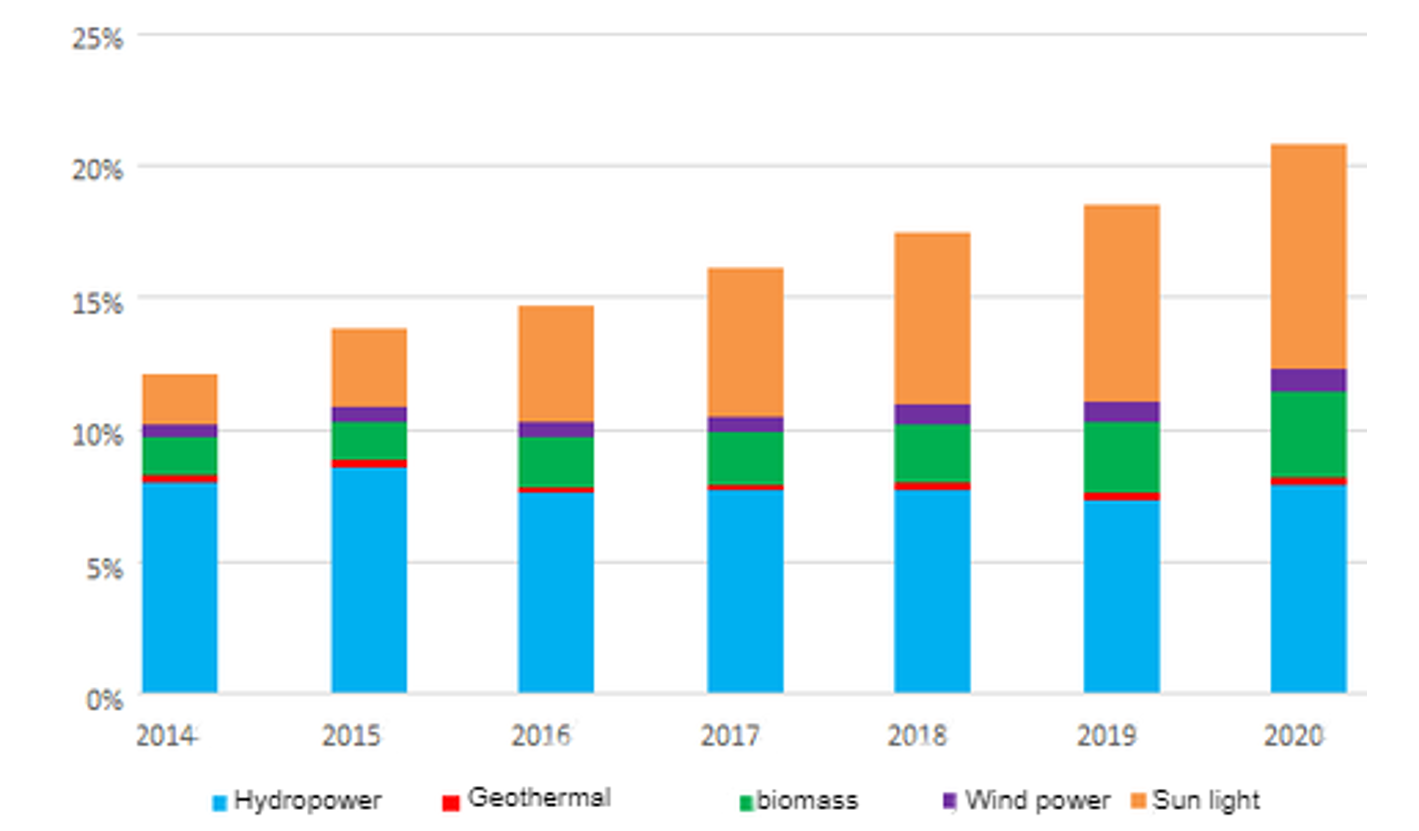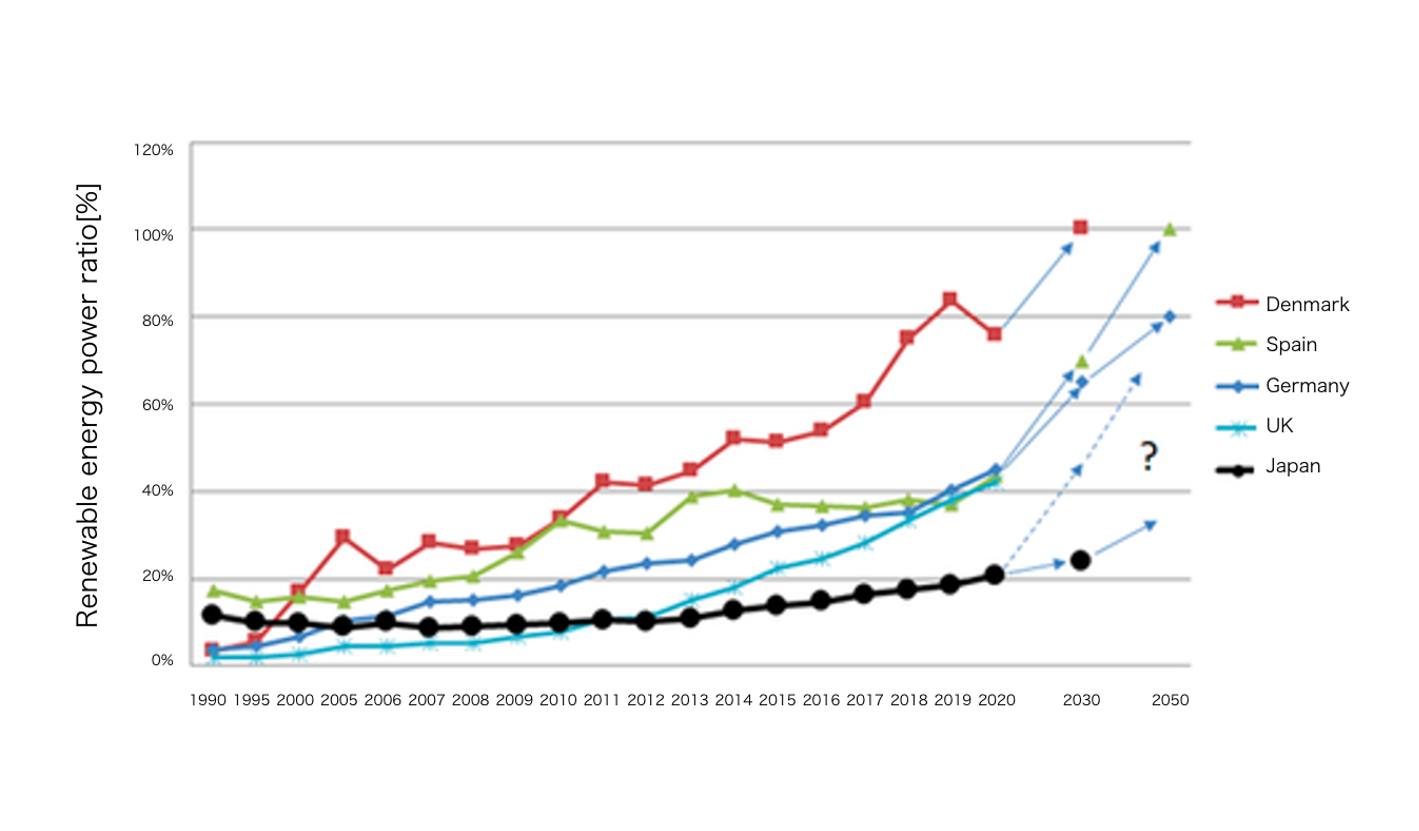 Home
Home
 Energy situation
Energy situation
 About RENEWABLE
About RENEWABLEenergy
 Think about energy
Think about energy
 Power saving check
Power saving check
 Summary
Summary
 language
languageEnergy situation in Japan and the world
On this page, we investigated the ratio of fossil fuels and renewable energy used for power
generation in Japan and overseas, and their transition. We also compared the energy
self-sufficiency
rates of Japan and the world.
Click to enlarge the image on this page!!
Figure 1: Power source composition for Japan as a whole (preliminary report for 2020) Source: Created by ISEP based on power survey statistics, etc.
According to the summary of the Institute for Environmental Energy Policy (ISEP), it is estimated that the ratio of natural energy to the total power generation in Japan in 2020 increased from 18.5% in the previous year to 20.8%. However, the ratio of fossil fuel-fired power generation has remained unchanged from the previous year at 74.9%, which is a high level as before. Since the number of nuclear power generation became zero in 2014, the amount of power generated has increased every year since 2015, reaching 6.5% in 2019, but decreasing to 4.3% in 2020.
Figure 2: Changes in the ratio of renewable energy to the total amount of electricity generated in Japan (Source: Created by ISEP based on power survey statistics, etc.)
The ratio of renewable energy, which was 12% in 2014, increased by about 1 point every year and reached more than 20% in 2020.
Comparison of the ratio of renewable energy, etc. to the amount of power generated by European countries and China / Japan (2020) Source: Created by ISEP from data such as Agora Energiewende, China Energy Potal, and electricity survey statistics
Comparing the changes in the ratio of renewable energy to the annual power generation of European countries and Japan from the 1990s to 2020, European countries have steadily increased the ratio of renewable energy from the 1990s toward 2020. I understand. In Denmark, for example, it was already 17% in 2000, but exceeded 30% in 2010, reached 75% in 2020, and aims to exceed 100% by 2030. (Right of the figure). Germany was around 7% in 2000, then increased to nearly 20% in 2010, reached 45% in 2020, more than 65% in 2030, and 80% in 2050. We are aiming for the above.
Impressions and comments so far
It turns out that more than 70% of Japan's energy still depends on fossil fuels. I learned that nuclear power is a very small percentage of our energy at present, even though we are spending money on building nuclear power plants all over the country. It was surprising that the ratio of renewable energy is five times that of nuclear power plants. On the other hand, it was found that the proportion of renewable energy in Japan is still low compared to European countries. When Denmark found it amazing that half of its electricity was supplied by wind power, many photos of many wind power generators being built offshore were searched. I would like to pay attention to the future movement of Denmark, such as the extent of the impact of marine pollution.
Impressions / comments
It turns out that more than 70% of Japan's energy still depends on fossil fuels. I learned that nuclear power is a very small percentage of our energy at present, even though we are spending money on building nuclear power plants all over the country. It was surprising that the ratio of renewable energy is five times that of nuclear power plants. On the other hand, it was found that the proportion of renewable energy in Japan is still low compared to European countries. When Denmark found it amazing that half of its electricity was supplied by wind power, many photos of many wind power generators being built offshore were searched. I would like to pay attention to the future movement of Denmark, such as the extent of the impact of marine pollution.
World and Japan energy self-sufficiency rate
According to a survey by the Agency for Natural Resources and Energy, Japan's self-sufficiency rate in 2018 was 11.8%. About 10 years ago, in 2010, the self-sufficiency rate was 20.3%, but due to various factors, it is at the current level. The major reason for the low self-sufficiency rate is the lack of energy resources in Japan. Fossil fuels such as petroleum, coal and liquefied natural gas (LNG) are heavily dependent on imports from abroad. Furthermore, due to the effects of the 2011 Great East Japan Earthquake, domestic nuclear power plants have been shut down, and dependence on fossil fuels is increasing. Japan depends on the Middle East for about 92% of its crude oil imports, and the Middle East is a region of very unstable political situation. In June 2019, there was an incident in which Japanese vessels were attacked in the Gulf of Oman near the Strait of Hormuz, which is an important transportation route for crude oil. It is said that if the Strait of Hormuz becomes difficult to navigate, global energy prices may rise. In preparation for such a situation, Japan is stockpiling oil for about 200 days.
Impressions / comments
I was surprised at the low energy self-sufficiency rate in Japan. I've noticed that gasoline is getting higher these days and less car pick-ups than before, but I'm a little scared to rely on imports for most of the energy that is directly linked to our lives. I was curious about Norway, which has a self-sufficiency rate of 700%, so I looked it up. In Norway, oil and gas have been produced in the North Sea since the 1970s, but the electricity produced in the country is mostly hydroelectric, and the produced oil and gas are hardly used in the country and exported. It is said that it is being turned to. Is the result of developing oil fields and at the same time developing renewable energy the difference from Japan's self-sufficiency rate? I feel that the light and darkness of Japan, which has spent money on nuclear power plants, has been divided.
summary
We want to cover our energy by ourselves. Can we make energy around ourselves without relying on fossil fuels?




